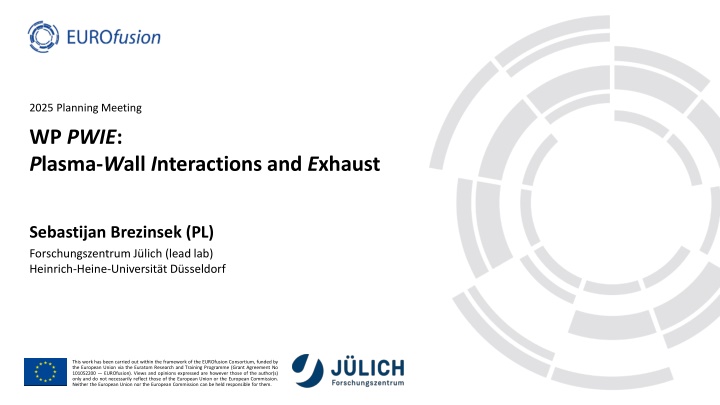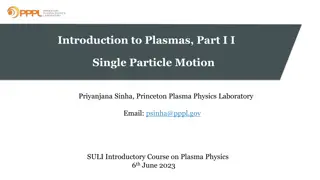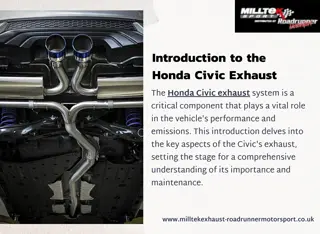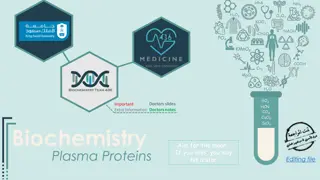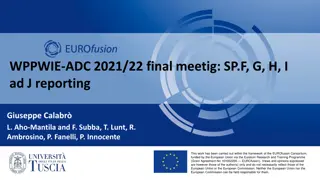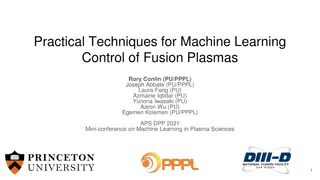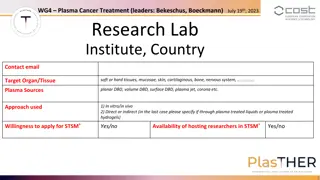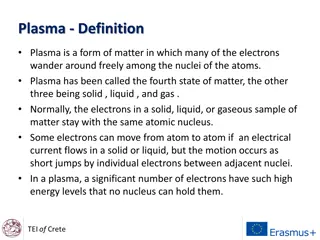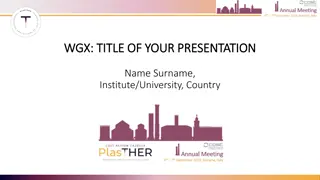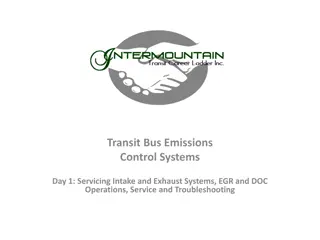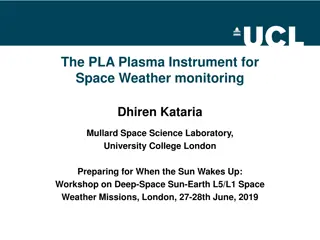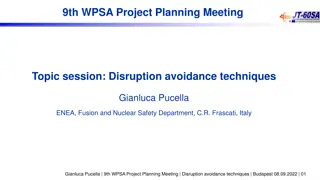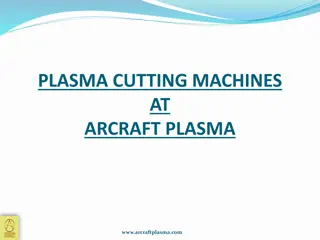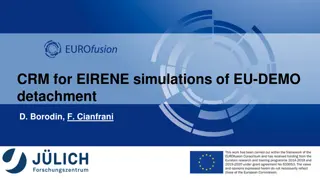Plasma-Wall Interactions and Exhaust Analysis
Work Package focusing on ITER and DEMO materials, radiative divertor, tungsten, seeding gases, isotope retention, plasma diagnostics, and material qualification for steady-state operation and future plasma research.
Download Presentation

Please find below an Image/Link to download the presentation.
The content on the website is provided AS IS for your information and personal use only. It may not be sold, licensed, or shared on other websites without obtaining consent from the author.If you encounter any issues during the download, it is possible that the publisher has removed the file from their server.
You are allowed to download the files provided on this website for personal or commercial use, subject to the condition that they are used lawfully. All files are the property of their respective owners.
The content on the website is provided AS IS for your information and personal use only. It may not be sold, licensed, or shared on other websites without obtaining consent from the author.
E N D
Presentation Transcript
2025 Planning Meeting WP PWIE: Plasma-Wall Interactions and Exhaust Sebastijan Brezinsek (PL) Forschungszentrum J lich (lead lab) Heinrich-Heine-Universit t D sseldorf This work has been carried out within the framework of the EUROfusion Consortium, funded by the European Union via the Euratom Research and Training Programme (Grant Agreement No 101052200 EUROfusion). Views and opinions expressed are however those of the author(s) only and do not necessarily reflect those of the European Union or the European Commission. Neither the European Union nor the European Commission can be held responsible for them.
Scope: Work Package Plasma-Wall Interactions and Exhaust Focus on ITER and DEMO materials, H and isotopes, He, seeding gases, and impurities Radiative divertor Tungsten + seed gas (Ne, Ar, Kr) Support in WPTE exploitation In AUG, WEST and JET in PWIE area with metallic PFCs Particle and heat flux Tungsten + Deuterium Goal: steady-state operation MAGNUM Support in WPW7X exploitation operating with Graphite towards Tungsten PFCs AUG ITER [T. Morgan] [M. Bernert] [K. Schmid] [S. Markelj] Recombining plasmas in PSI-2 and MAGNUM-PSI 3D erosion & deposition modelling Tungsten, (Beryllium), Boron Fuel (Tritium) retention Tungsten + Deuterium/Helium [J. Romazanov] Material qualification and synergistic effects of W and advanced W materials PWI diagnostic development 2 Sebastijan Brezinsek| 2025 Planning Meeting | Garching | June 11, 2024
Overview 2025 Original structure WBS and large fraction of activities prevail intact PSO: Michael Reinhart AI: LIBS spectra AI: SOL simulation Budget in July 3 Sebastijan Brezinsek| 2025 Planning Meeting | Garching | June 11, 2024
Overview 2025 Original structure WBS and large fraction of activities prevail intact (evolution) In view of the ITER re-baselining and abandon of Be and usage of W and W + B instead General activities related to Be (LIBS, fuel recovery assessment, ITER simulations etc.) were closed in 2023 Remaining activity is the JET-DT tile analysis (LIBS and ex-situ) with Be and W tiles to assess retention, migration, dust formation. Data feeds into benchmark of PWIE codes to validate physics models (low Z can be exchanged) Number of new activities to high priority ITER items related to clean W first wall operation (e.g. W sputtering and screening in limiter configuration, CXN fluxes etc.) and usage of boronisation (e.g. gettering, homogeneity) added Moderate change in facility portfolio in 2025 No JULE-PSI / reduced JUDITH-3 in operation in 2025 => transfer into HML in 2025 Risk mitigation: use more PSI-2 (all B aspects new) and MAGNUM (mainly W aspects) Risk mitigation: use GyM for B studies => linear machine budget will be reorganised Use HADES as JUDITH replacement if needed 4 Sebastijan Brezinsek| 2025 Planning Meeting | Garching | June 11, 2024
Focused Topic 2025: Layer formation/properties in full-W machines SP B: Understanding the formation of WEST-like deposits with W Final analysis of WEST-like deposits from long-pulse operation: stability and dust conversion factor Mimic WEST-like divertor plasma conditions and pulses in MAGNUM-PSI (and PSI-2) Thermal cycling of actively cooled W PFCs in NAGNUM-PSI and secondary upstream W source Role of surface temperature, thermal stresses, impurities, oxide formation, duty cycle etc. as parameters Pre- and post-characterisation and spectroscopy ERO simulations for linear plasma experiments (same A&M data for WEST) SP D: Simulation of WEST long-pulse plasmas in full 3D geometry (incl. ripple) Plasma boundary simulation with SOLEDGE3X-EIRENE ERO2.0 simulation of WEST long-pulse devices including W local redeposition and MB shaping SP A: HHF exposure of W MB exposed in WEST Damage evolution under e-beam loading Deposit stability assessment Linked to WP TE and WP DIV 5 Sebastijan Brezinsek| 2025 Planning Meeting | Garching | June 11, 2024
Focused Topic 2025: Composition of first wall fluxes and far-SOL PWI SP D: Simulation of fluxes to the first wall and W sputtering CXN and ion flux composition in simulations for COMPASS-U, AUG, (JET), ITER and DEMO SOLPS-ITER H-mode plasma simulations (ELM-averaged) Poloidal distribution of CXN with energy and angular distribution Role of inner and outer wall W source variation with change of CXN, D+, impurity ionisation level ERO2.0 simulations / WallDYN-3D simulations for AUG, JET (with W PFC,) ITER Comparison of cases with extended grid to the wall and normal grid to assed far-SOL profiles SP B: Gross and net W erosion at the first wall (manipulators) Experiments with RIG/ROG variation and light impurity seeding Pre- and post-characterisation of materials with different sputtering threshold and FIB cuts Comparison with PSI-2 plasma experiments Assessment of first wall W sources in view of ITER rebaselining Linked to WP TE, W7X and DES 6 Sebastijan Brezinsek| 2025 Planning Meeting | Garching | June 11, 2024
Focused Topic 2025: JET post-mortem analysis and simulation SP E: Erosion and deposition in JET / LIBS on RH demonstration LIBS data analysis and interpretation Application of AI with new project (learning ) Interpretation of erosion and deposition at limiters, inner divertor apron, and bulk-W divertor Collection of JET samples (if we manage to get them) =>Cutting => likely no analysis in 2025 Interpretation of H, D, T in W and Be => Retention information SP D: Simulation of material migration and fuel retention in JET Simulation of global transport with ERO2.0 combined with EDGE2D-EIRENE or SOLPS-ITER Simulation of retention in samples (co-deposits and implantation) Simulation of Ni CXN sources (already started) and migration Analysis of migration paths in different configurations Linked to WP TE 7 Sebastijan Brezinsek| 2025 Planning Meeting | Garching | June 11, 2024
Focused Topic 2025: Consequences of B application in ITER SP B: Samples for boronization (lab) and in manipulators B co-deposits and mixed B+O deposits Exposure in linear plasmas (PSI-2 / GyM) / lab plasmas / magnetron / (boronization) Impact of B on mirror properties SP C: Fuel retention and removal in B layers Retention in those layers as function of flux, temperature, composition (new scaling for T with B) Fuel removal assessment (microscopic) SP D: Simulation of material migration and fuel retention A&M data and MD simulation of boron chemistry Simulation of B migration in full-W devices in view of ITER needs Simulation of B lifetime and distribution (WallDYN-3D and ERO2.0) => Schmid already NF in 2024 SP F: Boronisation properties and wall conditioning Boronisation homogeneity and improved understanding of function / lifetime Wall conditioning techniques for fuel removal and B removal from B layers (ICWC, GDC, ECWC) on tiles Laser-based techniques application on very thin B layers and retention assessment Linked to IO and WP TE and W7X 8 Sebastijan Brezinsek| 2025 Planning Meeting | Garching | June 11, 2024
Focused Topic 2025: T in damaged W and steel / sensitivity increase SP X: Laser-based techniques as tool to interpret T retention mechanisms T retention in W by laser techniques has been demonstrated in damaged and undamaged material Increase of sensitivity required at no/low damage needed to provide input on physics of retention mechanisms with high spatial and depth resolution (advanced approaches) SP C: Damage mechanism in DEMO-relevant materials Retention of T in materials DEMO-like material temperatures (W, steel, EUROFER) Permeation of T through the materials into water (overlap with FTD?) Explore gentle D loading of n-damaged materials from fission reactors Linked to WP SAE, BB, MAT 9 Sebastijan Brezinsek| 2025 Planning Meeting | Garching | June 11, 2024
Deliverables PWIE Fusion Power phase. D5.19 PWIE.D.19 Characterization and predictive modelling of plasma-wall interactions in He und He/H mixed plasmas for ITER in Pre- 31/12/2025 PWIE MAGNUM-PSI and UPP including pre- and post-characterisation. D5.20 PWIE.D.20 High fluence exposition of mono blocks made of references W and advanced W materials for DEMO, JT-60SA, DTT in 31/12/2025 PWIE D5.21 PWIE.D.21 Fuel retention studies in self-damaged and neutron damaged materials exposed in JULE-PSI. 31/12/2025 PWIE regarding fuel/tritium content. D5.22 PWIE.D.22 Comparison of in-situ (LID-QMS in JET) and ex-situ examination (FREDIS, TDS) of the laser-irradiated components 31/12/2025 PWIE DEMO divertor (with TSVV-07). D5.23 PWIE.D.23 PSI modelling of DEMO main chamber erosion, deposition and fuel retention. PIC modelling of the sheath in the 31/12/2025 PWIE D5.24 PWIE.D.24 Neutral gas kinetics modular code upgraded and final verification/validation report (with TSVV-05). 31/12/2025 FPWIE D5.25 31/12/2025 PWIE.D.25 Initial PSI modelling of W sources, screening, transport and core concentration in full W-devices (with TSVV-06). 10 name| 2023 Technical Report - Meeting with EC | May 24, 2024
